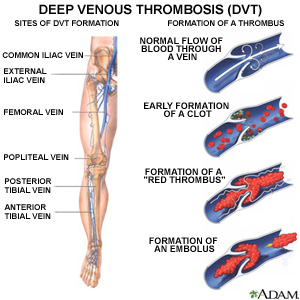WHAT YOU NEED TO KNOW: What do I need to know about peripheral thrombolysis? Peripheral thrombolysis is a procedure to break up or dissolve a blood clot in your arm or leg. The clot may be removed with a device during the procedure. You may need thrombolysis to remove a clot quickly so it does not break free. You may need the procedure to remove a blood clot from deep veins, called deep vein thrombosis (DVT). A DVT usually happens in a leg, but it can also happen in an arm. A DVT can also break free. A clot that breaks off in your arm or leg may travel to your lungs. This can be life-threatening. 
|
How do I prepare for the procedure? Your healthcare provider will tell you how to prepare for your procedure. He may tell you not to eat or drink anything after midnight on the day of your procedure. He will tell you what medicines to take or not take on the day of your procedure. You may be given contrast liquid before or during the procedure to help your healthcare provider see the clot better. Tell your healthcare provider if you have ever had an allergic reaction to contrast liquid. You may also be given antibiotics to prevent an infection caused by bacteria. What will happen during the procedure? - You will be given local anesthesia to numb the procedure site. Your healthcare provider may choose a vein or artery in your leg, arm, groin, or elbow. With local anesthesia, you may still feel pressure or pushing, but you should not feel any pain. Your healthcare provider will inject medicine into your IV that will help dissolve or break up the clot. It is most often given into a vein, but it may be given into an artery. A catheter is guided by x-ray so it is near the blood clot.
- Your heart rate and blood pressure will be monitored. Healthcare providers may also frequently check your neurological (neuro) status. Your neuro status is checked to see how well your brain is working. Healthcare providers may check your eyes, your memory, and your hand grasp.
What will happen after the procedure? Healthcare providers will apply pressure on the procedure site to stop any bleeding. You will be monitored closely for any problems. Do not get out of bed until your healthcare provider says it is okay. You will then be able to go home or be taken to your hospital room. - The catheter may be left in place if the medicine needs to continue to break up the clot. You will need to stay in the hospital if the catheter is left in place. Your healthcare provider will need to do the thrombolysis again to remove the rest of the clot.
- You will be told not to move the leg or arm used for the procedure while the catheter is in place. You will need to lie still. Tell your healthcare provider if lying flat starts to cause back discomfort. If there is no bleeding, he may help you roll onto your side.
- You must use a bedpan or a urinal until you are able to get out of bed and go to the bathroom. If you are unable to use a bedpan or urinal, a Foley catheter may be placed in your bladder. This catheter allows urine to drain from your bladder into a collection bag.
- You may need to wear pressure stockings or inflatable boots if your procedure was for a leg clot. The stockings are tight and put pressure on your legs. The boots have an air pump that tightens and loosens different areas of the boots. Both of these improve blood flow and help prevent clots. You may need to continue wearing pressure stockings after you leave the hospital. Your healthcare provider will tell you when to start wearing the stockings and how long to wear them each day.
- You will need to walk around the same day of your procedure, or the day after. Movement will help prevent blood clots. You may also be given exercises to do in bed. Do not get out of bed on your own until your healthcare provider says you can. Ask before you get up the first time. You may need help to stand up safely. When you are able to get up on your own, sit or lie down right away if you feel weak or dizzy. Then press the call button to let someone know you need help.
- Medicines:
- Anticoagulants are a type of blood thinner medicine that helps prevent clots. Anticoagulants may cause you to bleed or bruise more easily.
- Antiplatelets help prevent blood clots. This medicine makes it more likely for you to bleed or bruise.
What are the risks of peripheral thrombolysis? Thrombolysis increases your risk for bleeding. You may have increased nosebleeds or bleeding from your gums. You may also have bleeding in your stomach or brain. Bleeding can become severe and life-threatening. You may have an allergic reaction to the contrast liquid or to the medicine used to break up the clot. |